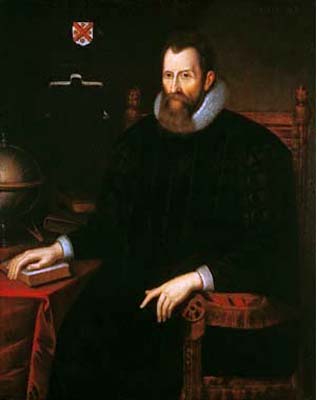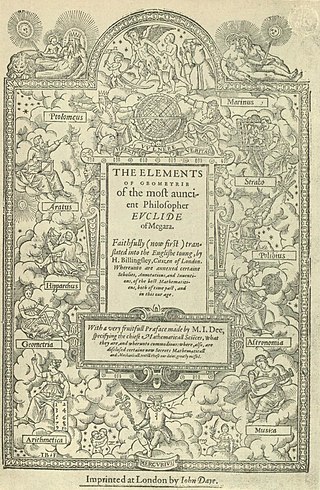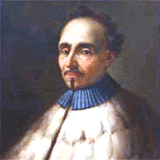Related Research Articles

Euclid was an ancient Greek mathematician active as a geometer and logician. Considered the "father of geometry", he is chiefly known for the Elements treatise, which established the foundations of geometry that largely dominated the field until the early 19th century. His system, now referred to as Euclidean geometry, involved new innovations in combination with a synthesis of theories from earlier Greek mathematicians, including Eudoxus of Cnidus, Hippocrates of Chios, and Theaetetus. With Archimedes and Apollonius of Perga, Euclid is generally considered among the greatest mathematicians of antiquity, and one of the most influential in the history of mathematics.

Euclidean geometry is a mathematical system attributed to ancient Greek mathematician Euclid, which he described in his textbook on geometry, Elements. Euclid's approach consists in assuming a small set of intuitively appealing axioms (postulates) and deducing many other propositions (theorems) from these. Although many of Euclid's results had been stated earlier, Euclid was the first to organize these propositions into a logical system in which each result is proved from axioms and previously proved theorems.

Geometry arose as the field of knowledge dealing with spatial relationships. Geometry was one of the two fields of pre-modern mathematics, the other being the study of numbers (arithmetic).

The history of mathematics deals with the origin of discoveries in mathematics and the mathematical methods and notation of the past. Before the modern age and the worldwide spread of knowledge, written examples of new mathematical developments have come to light only in a few locales. From 3000 BC the Mesopotamian states of Sumer, Akkad and Assyria, followed closely by Ancient Egypt and the Levantine state of Ebla began using arithmetic, algebra and geometry for purposes of taxation, commerce, trade and also in the patterns in nature, the field of astronomy and to record time and formulate calendars.

John Napier of Merchiston., nicknamed Marvellous Merchiston, was a Scottish landowner known as a mathematician, physicist, and astronomer. He was the 8th Laird of Merchiston. His Latinized name was Ioannes Neper.
In mathematics, non-Euclidean geometry consists of two geometries based on axioms closely related to those that specify Euclidean geometry. As Euclidean geometry lies at the intersection of metric geometry and affine geometry, non-Euclidean geometry arises by either replacing the parallel postulate with an alternative, or relaxing the metric requirement. In the former case, one obtains hyperbolic geometry and elliptic geometry, the traditional non-Euclidean geometries. When the metric requirement is relaxed, then there are affine planes associated with the planar algebras, which give rise to kinematic geometries that have also been called non-Euclidean geometry.

The Elements is a mathematical treatise consisting of 13 books attributed to the ancient Greek mathematician Euclid c. 300 BC. It is a collection of definitions, postulates, propositions, and mathematical proofs of the propositions. The books cover plane and solid Euclidean geometry, elementary number theory, and incommensurable lines. Elements is the oldest extant large-scale deductive treatment of mathematics. It has proven instrumental in the development of logic and modern science, and its logical rigor was not surpassed until the 19th century.
The timeline below shows the date of publication of possible major scientific breakthroughs, theories and discoveries, along with the discoverer. This article discounts mere speculation as discovery, although imperfect reasoned arguments, arguments based on elegance/simplicity, and numerically/experimentally verified conjectures qualify. The timeline begins at the Bronze Age, as it is difficult to give even estimates for the timing of events prior to this, such as of the discovery of counting, natural numbers and arithmetic.

In linear algebra, a squeeze mapping, also called a squeeze transformation, is a type of linear map that preserves Euclidean area of regions in the Cartesian plane, but is not a rotation or shear mapping.
Edmund Gunter, was an English clergyman, mathematician, geometer and astronomer of Welsh descent. He is best remembered for his mathematical contributions, which include the invention of the Gunter's chain, the Gunter's quadrant, and the Gunter's scale. In 1620, he invented the first successful analogue device which he developed to calculate logarithmic tangents.

Nicholas (Nikolaus) Mercator, also known by his German name Kauffmann, was a 17th-century mathematician.

Grégoire de Saint-Vincent - in Latin : Gregorius a Sancto Vincentio, in Dutch : Gregorius van St-Vincent - was a Flemish Jesuit and mathematician. He is remembered for his work on quadrature of the hyperbola.
The sector, also known as a proportional compass or military compass, was a major calculating instrument in use from the end of the sixteenth century until the nineteenth century. It is an instrument consisting of two rulers of equal length joined by a hinge. A number of scales are inscribed upon the instrument which facilitate various mathematical calculations. It was used for solving problems in proportion, multiplication and division, geometry, and trigonometry, and for computing various mathematical functions, such as square roots and cube roots. Its several scales permitted easy and direct solutions of problems in gunnery, surveying and navigation. The sector derives its name from the fourth proposition of the sixth book of Euclid, where it is demonstrated that similar triangles have their like sides proportional. Some sectors also incorporated a quadrant, and sometimes a clamp at the end of one leg which allowed the device to be used as a gunner's quadrant.

The history of logarithms is the story of a correspondence between multiplication on the positive real numbers and addition on the real number line that was formalized in seventeenth century Europe and was widely used to simplify calculation until the advent of the digital computer. The Napierian logarithms were published first in 1614. E. W. Hobson called it "one of the very greatest scientific discoveries that the world has seen." Henry Briggs introduced common logarithms, which were easier to use. Tables of logarithms were published in many forms over four centuries. The idea of logarithms was also used to construct the slide rule, which became ubiquitous in science and engineering until the 1970s. A breakthrough generating the natural logarithm was the result of a search for an expression of area against a rectangular hyperbola, and required the assimilation of a new function into standard mathematics.
Algebra can essentially be considered as doing computations similar to those of arithmetic but with non-numerical mathematical objects. However, until the 19th century, algebra consisted essentially of the theory of equations. For example, the fundamental theorem of algebra belongs to the theory of equations and is not, nowadays, considered as belonging to algebra.

Pietro Mengoli was an Italian mathematician and clergyman from Bologna, where he studied with Bonaventura Cavalieri at the University of Bologna, and succeeded him in 1647. He remained as professor there for the next 39 years of his life.
This is a timeline of pure and applied mathematics history. It is divided here into three stages, corresponding to stages in the development of mathematical notation: a "rhetorical" stage in which calculations are described purely by words, a "syncopated" stage in which quantities and common algebraic operations are beginning to be represented by symbolic abbreviations, and finally a "symbolic" stage, in which comprehensive notational systems for formulas are the norm.

Oliver Byrne was a civil engineer and prolific author of works on subjects including mathematics, geometry, and engineering. He is best known for his 'coloured' book of Euclid's Elements. He was also a large contributor to Spon's Dictionary of Engineering.
Alī ibn Walī Ibn Hamza al-Maghribi, also known as Ibn Hamza Al-Gaza'iri was a 16th-century Algerian mathematician. He was born between 1554-1575 in Algiers in Ottoman Algeria and died around 1611, during the rule of Murad III.
Henry Sutton was an English instrument maker who operated out of London from 1650 to 1661. He is known for his high-quality engravings of scales and quadrants.
References
- ↑ Beeley, Philip (June 2019). "Practical mathematicians and mathematical practice in later seventeenth-century London". The British Journal for the History of Science. 52 (2): 225–248. doi:10.1017/S0007087419000207. PMID 31198123.
- ↑ Logarithmotechnia, or, The making of numbers called logarithms to twenty five places from a geometrical figure. OCLC 12621300 . Retrieved 13 March 2020– via WorldCat.
- ↑ Euclid Speidell (1688) Logarithmotechnia: the making of numbers called logarithms at Google Books
- ↑ 84b Whitechapel High Street from Survey of London
- ↑ Jardine, Boris (2008). "The 'incomparable' Mr. Sutton: a famous 17th-century instrument maker". Whipple Collections. Whipple Museum of History and Science. Retrieved 29 October 2016.